This article was co-authored by Tian Zhou and by wikiHow staff writer, Jennifer Mueller, JD. Tian Zhou is a Language Specialist and the Founder of Sishu Mandarin, a Chinese Language School in the New York metropolitan area. Tian holds a Bachelor's Degree in Teaching Chinese as a Foreign Language (CFL) from Sun Yat-sen University and a Master of Arts in Teaching English to Speakers of Other Languages (TESOL) from New York University. Tian also holds a certification in Foreign Language (&ESL) - Mandarin (7-12) from New York State and certifications in Test for English Majors and Putonghua Proficiency Test from The Ministry of Education of the People's Republic of China. He is the host of MandarinPod, an advanced Chinese language learning podcast.
There are 13 references cited in this article, which can be found at the bottom of the page.
wikiHow marks an article as reader-approved once it receives enough positive feedback. This article has 12 testimonials from our readers, earning it our reader-approved status.
This article has been viewed 600,908 times.
More than 400 million people around the world speak some version of Arabic. It is an official language in 27 countries and a national or minority language in 6 others.[1] If you want to learn this global language, start with the alphabet. It may seem easier to rely on transliterated Arabic if you only want to speak, but this can cause you problems if you later decide you want to learn how to read and write the language. Learning the sounds the letters make will give you an advantage because you'll be able to sound out and correctly pronounce words you don't know. Once you have the basic alphabet and pronunciation down, you can work on reading, writing, and speaking Arabic.
Steps
Mastering the Alphabet and Pronunciation
-
1Download an alphabet chart to practice Arabic letters. You can download a basic printable chart at https://omniglot.com/charts/print/arabic.pdf and use it to study the Arabic alphabet. Spend about 20 minutes a day on a letter or two and you'll have the alphabet mastered in less than a month.[2]
- Stanford University has an interactive chart available at https://web.stanford.edu/dept/lc/arabic/alphabet-disable/ that will help you learn how to write the letters properly.
- Visit https://www.arabic-course.com/arabic-alphabet.html for a free online video course on the Arabic alphabet.
-
2Study how letters change form. Most letters of the Arabic alphabet change form depending on where they appear in a word. They may have a different form if they come at the beginning, middle, or end of a word. Many also have a different form if they appear on their own.[3]
- Arabic Reading Course, available at http://arabicreadingcourse.com/index.html, is designed to help you recognize individual letters in words. The basic version is free and can also be used on mobile devices. If you pay for the premium version, you get additional flashcards and quizzes.
Advertisement -
3Study English Phonology. Phonology deals with English pronunciation. English pronunciation is similar to Arabic pronunciation. English Phonology helps in understanding Arabic pronunciation. You can find many websites and online videos on English Phonology.
-
4Listen to the alphabet spoken by native speakers. To get the sounds of the letters right, try to mimic the sounds as pronounced by a native speaker. Since the sound may differ depending on the dialect of Arabic the person speaks, make sure you stay consistent with the dialect you plan to learn.[4]
- You can watch and listen to a basic video introducing the Arabic alphabet and the sound each letter makes at https://youtu.be/53Nf8xVrN24. There are plenty of similar videos on YouTube that can also help you.
- When watching videos, try to write down the words that appear most frequently or the ones you think are most important (usually, the most practical ones).
Tip: Pronunciation may differ depending on the dialect spoken by the person in the video. Try to keep your studying within the same dialect to avoid confusion.
-
5Familiarize yourself with vowel diacritics and other symbols. Diacritics are used to mark short vowels. Although you'll commonly only see them in the Qu'ran, you may see them in children's books or language-learning books designed either for adults or children.[5]
- Diacritics and other marks are designed to help you understand how to pronounce words in written Arabic or to distinguish similarly spelled words so you can tell them apart when you're just learning the language and may not completely understand the context.
Using Online Resources
-
1Download Arabic language resources for free. There are many online language courses and materials available for purchase, but you can also access language learning resources for free. While the free courses may not bring you to fluency, they will help you get a jumpstart on learning Arabic in a structured way.[6]
- Download Arabic language courses from the US Foreign Service Institute (FSI) at https://www.livelingua.com/arabic/courses/fsi/. The FSI courses include the Levantine (Jordan, Lebanon) and Hijazi (Saudi Arabia) Arabic dialects, as well as written Arabic.
- Flashcards can be a great tool in helping you learn a new language. They’re easy to make, carry, and even dispose of. As long as they serve the purpose of helping you memorize the new vocabulary, you don't need to create anything fancy.
Tip: If you want to learn colloquial Arabic, choose one dialect to focus on at a time so you don't get confused.
-
2Get learning apps for your mobile devices. Many of the mobile learning apps use gamification, turning your learning into a game to win awards and earn badges and other in-game prizes and bonuses as you unlock each new section. While you likely won't achieve fluency through these apps, they can help you expand and reinforce your vocabulary and teach you basic grammar.[7]
- Some popular apps include Tinycards, Duolingo, Memrise, and Clozemaster. You can use these apps for free. However, there are also premium features in each app that you'll have to pay to access.
-
3Watch TED talks with Arabic subtitles and transcripts. While the talks themselves are in English, you can read the transcripts in Arabic and then check the video for comprehension. Try writing an English translation of the Arabic then compare that to the actual talk.[8]
- Look for TED talks by Arabic activists and natives. They will give you a glimpse into the culture and issues facing Arab nationals.
-
4Speak Arabic online with native speakers. On websites such as Lang-8, MyLanguageExchange.com, and Italki, you can connect with native speakers to practice your Arabic skills. Typically, the exchange involves you helping them with a language they are trying to learn. In exchange, they help you with your Arabic.[9]
- The quickest way to be fluent is to immerse yourself in the target language environment as much as possible, and use it as often as possible.
- Some of these exchanges also have mobile apps so you can chat with your language partner on your smartphone or other mobile device.
- Basic access to these sites is typically free, although you may have to pay a monthly subscription fee to unlock premium features.
-
5Take language level testing online for free. Many language learning software companies and language schools offer language level testing for free. Once you get further involved in your Arabic study, level testing can be a good way to assess your progress. Testing at a particular level also allows you to put your relative proficiency in Arabic on your résumé and work or school applications.[10]
- Sprachcaffe, a leading language school in Europe, offers free Arabic level testing at https://www.sprachcaffe.com/us/english/language-test.htm. Simply scroll down and click on the link for the "Online Arabic Proficiency Test."
- Cactus Language offers free Arabic language testing at https://www.cactuslanguage.com/language-level-tests/. The course uses transliterated Arabic.
Tip: Because they test your reading comprehension and translation skills, most language level tests use Modern Standard Arabic (MSA).
Immersing Yourself in the Language
-
1Translate your daily native language into Arabic. Just imagine you went to a market. Then think how you would interact with people. Write the whole conversation in your native language then write the Arabic equivalent under every sentence.
-
2Listen to Arabic music. Listening to Arabic music is a great way to immerse yourself in the language as well as become more familiar with common words and phrases. The typically repetitive nature of song lyrics reinforces the words and phrases in your mind.[11]
- Major music streaming services typically have an Arabic channel or Arabic playlists. Check with your favorite streaming service to find out what's available.
- If you happen upon an artist that you like, search them online. You may be able to download their albums or watch music videos for some of the songs you like.
-
3Watch movies and television in Arabic. Movies and television allow you to listen to more natural Arabic conversations. Many popular movies have also been dubbed into Arabic, so if you find a movie you're already familiar with, you'll find you start to comprehend a lot more of what's going on and what the characters are saying.[12]
- Fantasy and historical drama tend to be dubbed in Modern Standard Arabic (MSA), while contemporary comedies and dramas are usually dubbed in either Egyptian Arabic or Levantine Arabic.
- Reality television tends to use a limited vocabulary and exposes you to more realistic unscripted conversations.
-
4Read children's books in Arabic. You likely learned how to read in your native language with simple children's books. This is also an effective way to start reading Arabic. Copying the sentences from the stories can help you practice your writing as well.[13]
- Visit the Arabic Collections Online at http://dlib.nyu.edu/aco/ to access more than 10,000 free digitized books in Arabic.
-
5Label items around your house with their Arabic names. Use sticky notes to write the Arabic word for objects in your home and label them. Every time you see the object, repeat the Arabic word for that object aloud. Over time, you'll come to think of that object by its Arabic name first. This can be a great way to expand your vocabulary as well as get your brain used to thinking in Arabic.[14]
- Extensive Arabic vocabulary lists are available at http://arabic.desert-sky.net/vocab.html to help you create your labels.
- Once you've committed your first set of labels to memory, take them off and use different labels. Generally, it's a good idea to go from large to small so you don't get confused about what the label applies to. For example, you might first label your sofa as a whole, then add labels for "arm" or "cushion."
-
6Practice reading and listening comprehension with Al Jazeera. Al Jazeera has a website available at https://learning.aljazeera.net/en that offers news as well as basic learning stories and videos in basic Arabic to help you learn the language. From the website, you can also take language level tests or chat with an Arabic teacher.[15]
- Even if you don't use the video resources, you can take advantage of the online dictionary available on the site to look up words you don't know.
- Al Jazeera broadcasts and language lessons primarily focus on Modern Standard Arabic (MSA). However, you'll also find lessons on Mediterranean Arabic.
Tip: Start with the simpler learning site. You can move on to the regular news site once you feel that you can comprehend the Arabic spoken there.
-
7Travel to an Arabic country. The ultimate test of immersion is spending time in a country where the majority of the people speak Arabic. Simply sitting at a café and listening to the conversation around you can help improve your comprehension.[16]
- Try to go to a country that speaks the form of Arabic you've been studying, or you may find you have a difficult time understanding people despite your study. For example, if you've been studying Levantine Arabic, you would want to travel to Lebanon or Jordan rather than to Egypt.
Community Q&A
-
QuestionWhat is the meaning of the words: ana anta anti huma?
 Community AnswerThe words are as follows: ana- I; anta - you (for males); anti - you (for females); huma - they (for two people); and hum - they (for more than two people).
Community AnswerThe words are as follows: ana- I; anta - you (for males); anti - you (for females); huma - they (for two people); and hum - they (for more than two people). -
QuestionWhat are some good books I can read to learn Arabic?
 Community AnswerTry reading children's books at first to grow your vocabulary and get used to the characters.
Community AnswerTry reading children's books at first to grow your vocabulary and get used to the characters. -
QuestionWill it be easier for me to learn if I know how to read Arabic fluently but don't understand it?
 Community AnswerKnowing the different alphabet and word pronunciations should make it easier to learn Arabic.
Community AnswerKnowing the different alphabet and word pronunciations should make it easier to learn Arabic.
References
- ↑ http://gratisglobal.com/learn-arabic-free/
- ↑ https://omniglot.com/writing/arabic.htm
- ↑ https://omniglot.com/writing/arabic.htm
- ↑ https://omniglot.com/writing/arabic.htm
- ↑ https://omniglot.com/writing/arabic.htm
- ↑ https://www.livelingua.com/arabic/courses/fsi/
- ↑ http://gratisglobal.com/learn-arabic-free/#apps
- ↑ https://www.ted.com/talks?language=ar
- ↑ http://gratisglobal.com/learn-arabic-free/#practice-with-native-speakers
- ↑ http://gratisglobal.com/learn-arabic-free/#language-tests
- ↑ http://arabic.desert-sky.net/links.html#mus
- ↑ http://arabic.desert-sky.net/links.html#mov
- ↑ http://www.openculture.com/2019/02/download-more-than-10000-books-in-arabic-all-completely-free-digitized-and-put-online.html
- ↑ http://arabic.desert-sky.net/vocab.html
- ↑ https://learning.aljazeera.net/en
- ↑ https://www.gooverseas.com/blog/where-learn-arabic-abroad
- ↑ https://omniglot.com/writing/arabic.htm
About This Article
To learn Arabic, work on your pronunciation and vocabulary by watching Arabic news or listening to Arabic music. You can also join a pen-pal website and correspond with an Arabic-speaker to practice writing Arabic characters. If you can, connect with someone who speaks Arabic online, then spend an hour each week practicing vocabulary and basic phrases on a video call with them. For tips on how to find the best at-home or online Arabic courses, read on!
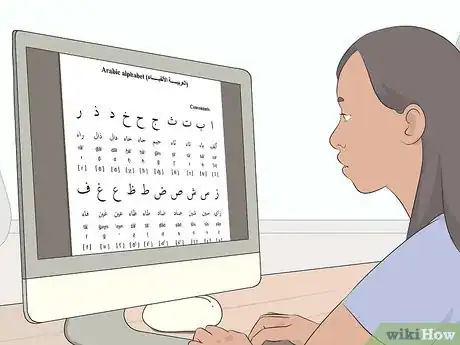

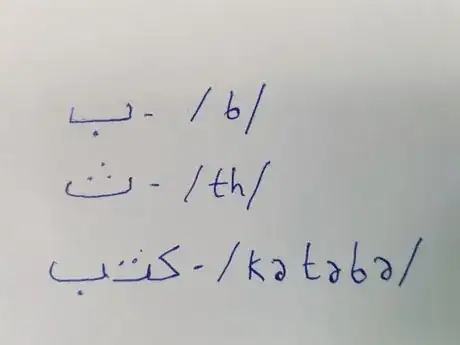

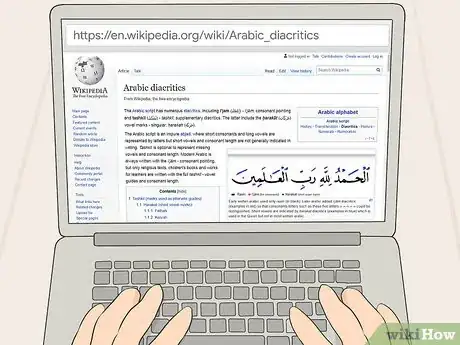










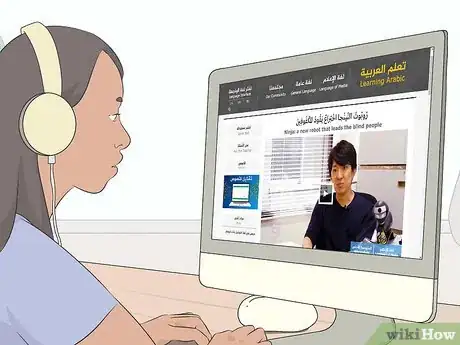









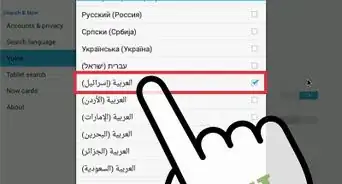
-Step-3-Version-2.webp)

















































